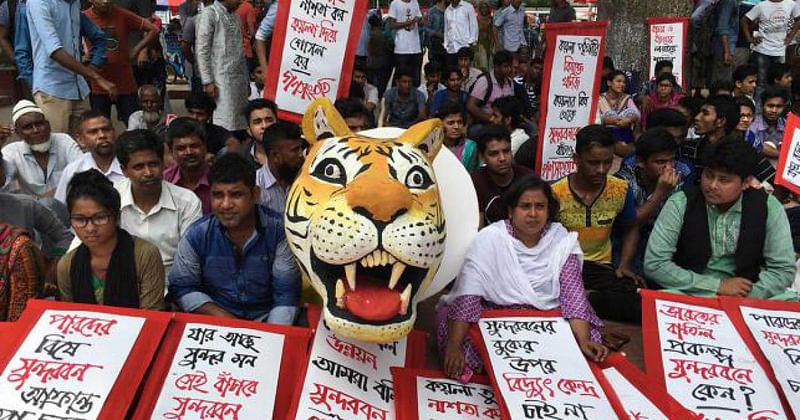Unesco calls for shelving Rampal project

The United Nations Educational, Scientific and Cultural Organisation (Unesco) has recommended that Bangladesh shelve the Rampal coal-fired power plant, which is being constructed in close proximity to the Sundarbans. It said the project would cause irreparable damage to the forest and should be relocated.
The three-member Unesco expert team which visited Bangladesh in March, made this appeal in their report submitted to the government. They said at the moment the Sundarbans would not be moved from the world heritage list to the endangered world heritage list, but requested for the Rampal project to be shelved and for Unesco’s recommendations to be followed. They said a decision in this regard would be taken at the 2017 World Heritage Commission meet.
The Unesco report said the Environmental Impact Assessment (EIA) report found many discrepancies between the statements of Rampal project construction firm Bangladesh-India Friendship Power Company and the tender documents. During their Bangladesh visit, the team was only allowed to meet a limited number of experts. And the interaction with the local people was also organised by the company.
State minister for power and energy Nasrul Hamid told Prothom Alo, “Unesco’s report has given recommendations on many aspects of the Sundarbans, not just Rampal. The viability of these suggestions needs to be assessed. We will reply to the points raised by Unesco. In the meantime, work on the Rampal project will not stop.”
Meanwhile, the member secretary of the committee to protect oil-gas-mineral resources-power and ports, Anu Muhammad, told Prothom Alo, “The Unesco report proves that the statement we have been issuing so long is scientific and justified. Instead of mulling over how to reply to the Unesco report, the government should look into how speedily it can cancel this project.”
The Unesco report highlighted four risks regarding the Rampal project. These are, air pollution, water pollution, increased river traffic and accumulated pollution caused by industries and infrastructure coming up in the project area.
The proposed 1320 MW Rampal coal-fired thermal power plant project is situated 14 km from the Sundarbans and 65 km from Sundarbans world heritage site. It is feared that the coal ash emitted from the plant into the air will pollute the Sundarbans.
Brac University’s emeritus professor Ainun Nishat told Prothom Alo that it is being said the risks raised in the Unesco report can be tackled with technology. However, there are questions as to how effective such technology will actually be in protecting the Sundarbans.

Wild life at risk
The Unesco report highlighted the rich bio-diversity of the Sundarbans, the world’s largest mangrove forest. It is the home of the largest number of Royal Bengal Tigers, and other endangered species.
The report stated that in the last 150 years, the area of the Sundarbans has shrunk by half. Many species such as wild buffalos, certain types of deer, the Javan rhinoceros, hog deer, a certain type of crocodile and other animals are now extinct.
Incomplete EIA
The Unesco report has termed the Rampal EIA as incomplete and questionable. The views of all quarters were not taken into consideration in drawing up the report. This did not meet international EIA requirements.
The report said the project contractors Bharat Heavy Electrical Limited did not provide adequate data. Unesco also said a clear idea was not given about what technology would be used to address the pollution problems.
Acid rain
The burning of coal at Rampal will lead to emission of large amounts of sulphur dioxide, carbon dioxide, nitrous oxide and mercury. Sulphur dioxide and nitrous oxide will cause acid rain.
Acid rain will be a serious threat to Sundarban’s water biodiversity. Acid content in the rivers will increase.
Mercury in the food chain
Mercury emissions will also pollute the environment. It will enter human body through fish consumtion and people will face the consequences of mercury poisoning.
There is no technology as yet which can effectively contain mercury poisoning.
Air pollution
The government told the Unesco team that air pollution would be kept in check. The tall chimneys which are to be constructed, however, will simply spread the pollution far and wide, affecting the heritage site.
Water pollution
The power plant authorities have said they will use 5000 cubic metres of water per hour from the river Pasur to control the heat of the machinery. They did not mention the amount of water to be used for other purposes in the plant. The contaminated water will be released back into the river, polluting it further.
Accumulated pollution
A township and administrative infrastructure will be constructed around the Rampal power plant. Other development work will be carried out in the vicinity. Water for all of this will be taken from the river Pasur, according to Unesco.
The government has acquired land for the second phase of the Rampal power project. The second phase will cause further harm, contended Unesco.
Increased river transport
Unesco pointed out that the river Pasur which will be used to transport coal to the project, flows alongside the Sundarbans. The river will have to be dredged regularly to keep it navigable. There is no mention as to where the silt will be dumped and what effect this will have on the environment.
Award-winning wildlife specialist Professor Reza Khan told Prothom Alo that the polluted and heated water emitted from the Rampal power plant will increase the temperature of Pasur’s water by two degrees Celsius. This will harm the aquatic life, their food cycle, threatening the ecological balance of the entire Sundarbans.
Dr Reza Khan said that every inch of the Sundarbans is rich in biodiversity. It is irreplaceable. He said that the government must definitely take Unesco’s recommendations into consideration.